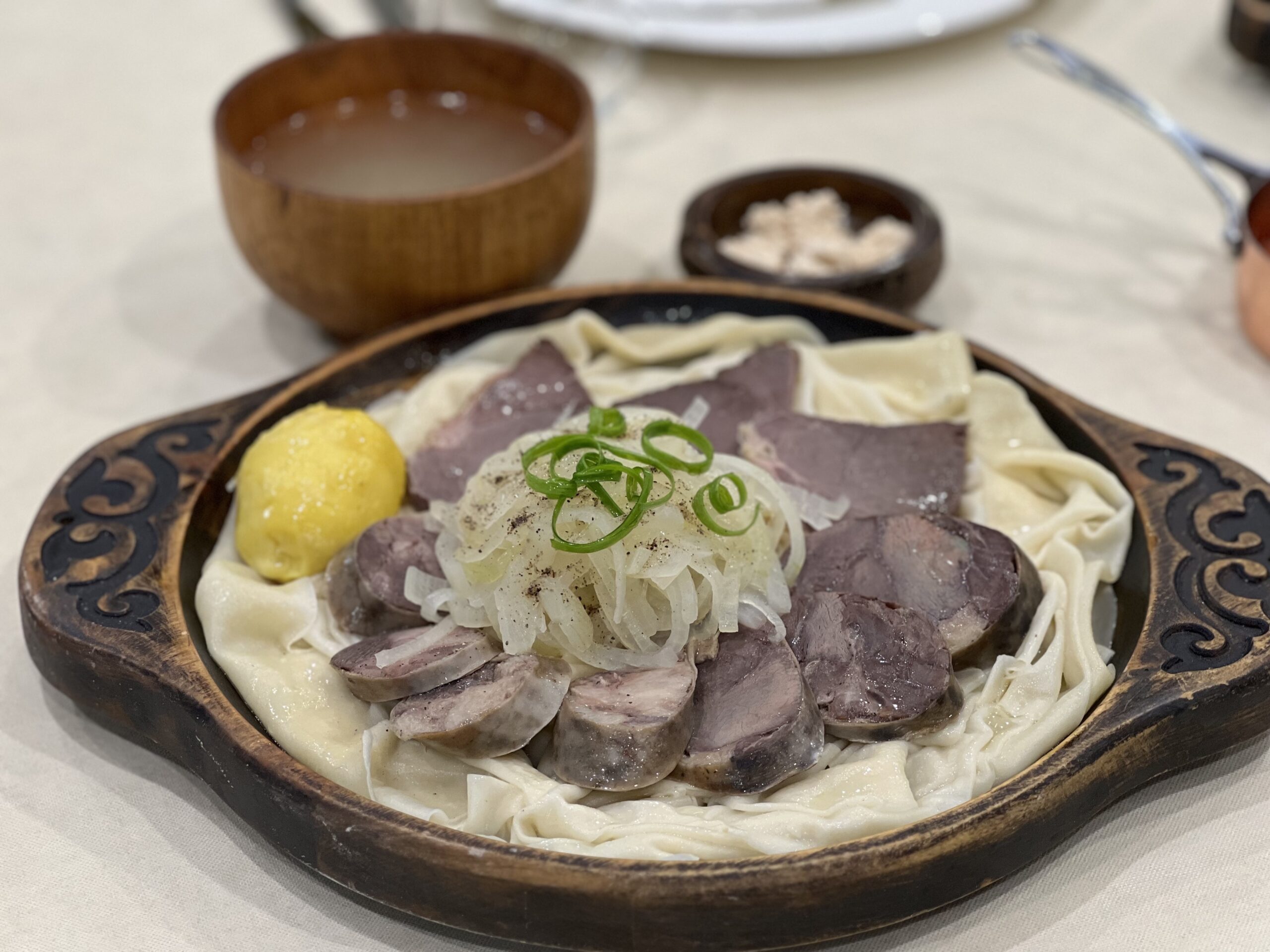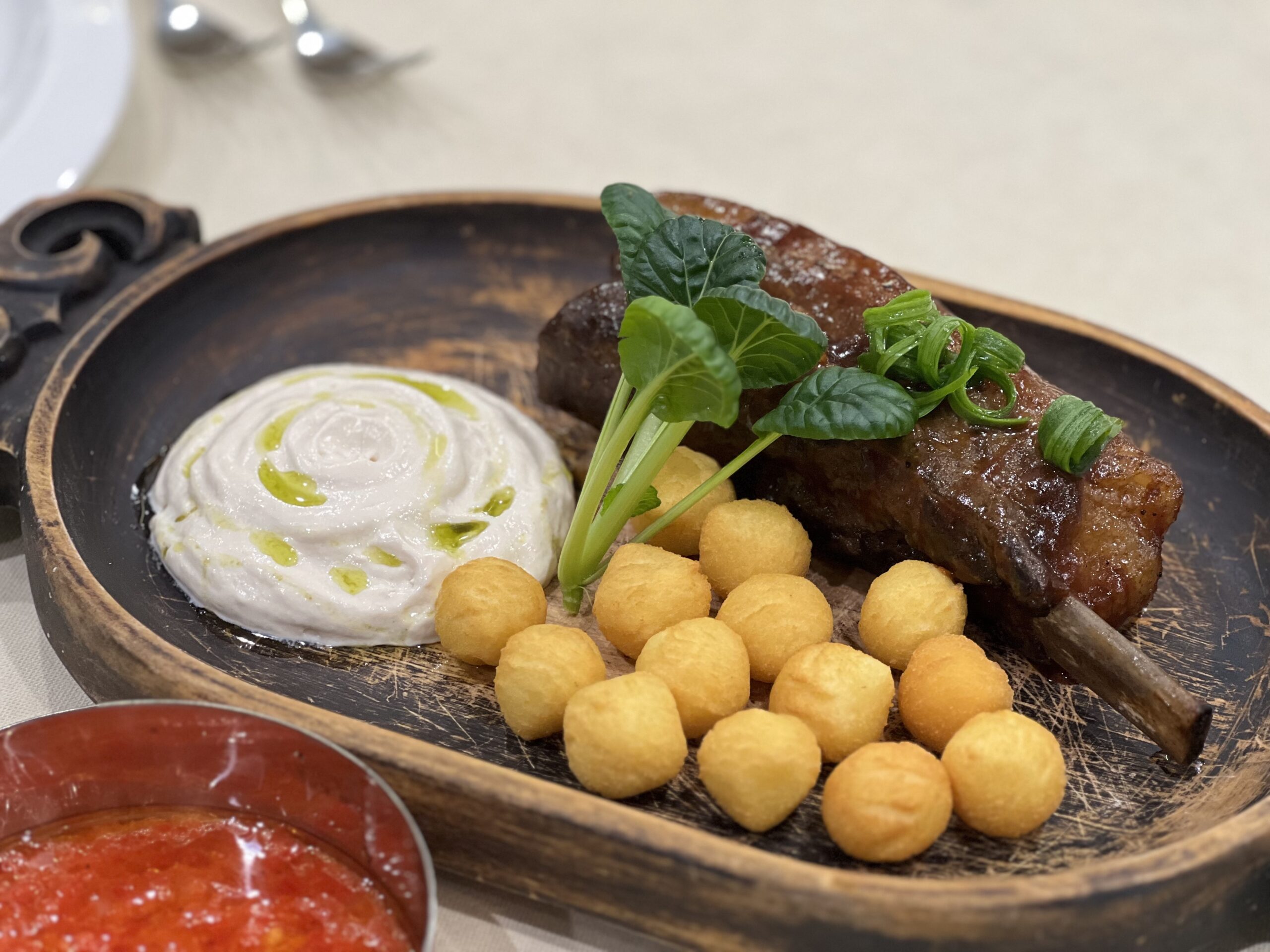ASTANA – A place where an exquisite dining experience can be paired with a niche musical exhibition is exactly what one would expect when dining at Daididau restaurant, curated by the family of renowned Kazakh singer Dimash Kudaibergen.

The interior in muted blue and gold color palette provides welcoming festive atmosphere. Photo credit: The Astana Times
If food nourishes the body and music the soul, Daididau becomes a place that serves both, with dishes that capture the breadth of Kazakh cuisine and an exhibition of musical instruments gifted to Kudaibergen during his tours worldwide.

Kudaibergen posing in front of Daididau restaurant. Photo credit: Instagram @kudaibergenov.dimash
When he launched the Daididau restaurant in November last year, Kudaibergen wrote he hoped it would become a “favorite place of every tourist who comes to Astana.”
Indeed, the waiters, who welcome guests the moment they enter, provide an inviting energy, combined with the rest of the venue decorated in a muted blue and gold color palette. The warm-toned decorations benefit from opulent chandeliers hanging overhead. The decor carries a Kazakh and Turkish influence, with tilework and fences showing Oriental patterns.
The restaurant has been named Daididau, which is a reference to the Kazakh song Kudaibergen performed at the Slavic Bazaar international contest in 2015 and won the Grand Prix. It is a fitting name for a restaurant that seeks to shine a light on the world’s musical heritage.
As its musical name suggests, the venue will transport its visitors to the world of music, courtesy of its vibrant collection of instruments gifted to Kudaibergen by his fans, from Turkish three-stringed baglama to Indonesian sasando and Ukrainian domra.

Daididau invites its guests for a guided tour through musical instruments exhibited in the restaurant. Photo credit: The Astana Times
The exhibition’s highlight is Kudaibergen’s costume that he wore at his concert in Almaty in 2022. Made up of golden metallic pieces on a red costume, it resembles Altyn Adam’s (Golden Man) attire, the archaeological finds of the Saka prince’s costume from the sixth-fifth century BC.
A deep dive into Kazakh cuisine
Daididau borrows many elements from the world’s latest gastronomy techniques while celebrating the rich Kazakh cuisine and the diverse flavors and textures of Kazakh traditional meals.

Kazaksha et (Kazakh-style meat), also known as beshbarmak, is a countrywide staple. Photo credit: The Astana Times
“Daididau is a fusion of north and south, east and west. It is a new breath of Kazakh cuisine. We also have musical exhibits as part of our concept. This restaurant, I hope, will be a guide for people who come to our country for the first time,” the restaurant’s brand chef Nariman Irzhanov told The Astana Times.
The kitchen, led by Irzhanov, aims to infuse traditional Kazakh dishes with a modern touch, adapting them into contemporary dining practices.
“I have worked in different regions and studied different recipes and flavors. We have a lot of Kazakh dishes, which can and should be modernized, adapted to be served at the restaurant,” he said.

Daididau’s brand chef Nariman Irzhanov. Photo credit: The Astana Times
The chef is no stranger to Kazakh cuisine.
“I am originally a bearer of Kazakh cuisine. All the time, I worked in national restaurants and went on all sorts of expeditions, where I learned cooking methods from the elders,” said Irzhanov.
The chef takes his inspiration from different cooking techniques used by Kazakhs for centuries, such as et surleu, which means hanging out the salted meat in the wind, or smoking and long cooking techniques.
The intriguingly named Genghis Khan’s Favorite Dish is an example of a traditional Kazakh dish served at a modern restaurant. The meat is aged in a cool place and then prepared without dishes on a stone on an open fire with the addition of steppe herbs.
“An open fire is another of the restaurant’s concepts. A stone is heated directly on an open fire. After that, we put the ripened meat on this stone and cook it. That type of dish was served when Genghis Khan went on campaigns. He liked to eat meat and used to cook it this way. The technology was taken exactly from the ancestors’ history,” said Irzhanov.
The restaurant sources all products locally. The team also works closely with farmers and local producers.
Three dishes to try at Daididau
When asked what dishes he would recommend and what makes them special, the chef shared three dishes satisfying diverse tastes – smoked and stewed kazy Ulytau, Kazakh-style meat and fish baked in salt solution.
Kazaksha et (Kazakh-style meat)
A countrywide staple, Kazakh-style meat, also known as beshbarmak, is a dish that every Kazakh has grown up with. Simple and nutritious, the meal of thin pasta squares and meat served with potatoes and onions is, arguably, the tastiest yet humblest of all Kazakh dishes.
“We serve traditional kazaksha et, which is made from horse meat. It is essential that there is a fat layer. This is the highest quality of meat,” said Irzhanov.
A bowl of kazakhsha et can be as basic or as elaborate as its diner’s preferences and the region it is prepared in, garnished with vegetables, made from lamb, beef or even fish. One needs to have it with hot sorpa (soup) and liquid kurt, which will be a perfect introduction to a nutritious Kazakh meal. It is a dish where one could feel free to dig in with one’s own hands.
Ulytau – smoked and stewed kazy (horse rib steak)
Tender and juicy is the way to go when it comes to steaks, and the Daididau’s horse rib steak is dripping.

Ulytau – smoked and stewed kazy (horse rib steak). Photo credit: The Astana Times
These meat types are not easy to perfect, but chef Irzhanov knows his way around the steaks. Kazy is marinated with various herbs and smoked according to a special recipe passed down from Kazakh ancestors. Then, it is stewed for 12 hours on low heat.
“It was initially very difficult to prepare it. In general, Kazakh cuisine is very hard to adapt [to a restaurant], because it used to be prepared in huge amounts for a large number of guests. We had to do a lot of work in that sense. First of all, we needed to keep the original flavor of the meat. Also, we paid attention to the shape and the presentation of the dish,” said Irzhanov.
Ulytau dish is served with crispy potatoes and yogurt made from kurt (hard salty cheese made from fermented milk). The yogurt is on the salty end, but the taste is not overpowering. The combination of meat and yogurt makes the dish even tastier.
Fish baked in salt solution
In the special dishes menu, Irzhanov tests the limits of what can be done in a gastronomic experience of Kazakh cuisine. Daididau pioneers molecular gastronomy, the culinary trend that deconstructs ingredients and recombines them in unexpected ways. They also cook using the sous vide technique of cooking vacuum-sealed food at a regulated temperature in a water bath.

Fish baked in salt solution. Photo credit: The Astana Times
The dishes have surprising combinations and textures, such as spaghetti from zhusai (a wild, fragrant onion) or spaghetti from cherry, lemon penna, among others.
One such dish is fish baked in salt solution. Fish is soaked in a salt solution to preserve its shape and beneficial properties. Served by the chef personally, the presentation of the dish is a work of art in itself. The taste does not disappoint, either.
With an average bill of 25-30$, it will not exactly break the bank.


